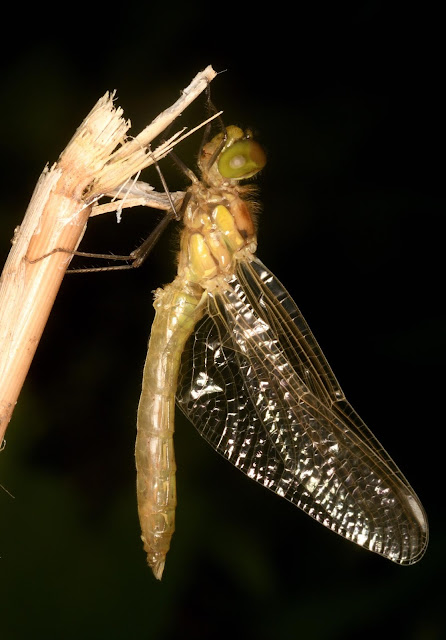This week, I have been photographing Dragonflies
 |
| Common Darter breaking free from its previous life as a Nymph. It will pump blood to the veins in its wings, to expand them ready for its maiden flight |
This week, we have experienced 44 degrees centigrade here in the Dordogne. In these temperatures, very little ventures out into the sunlight apart from crazy wildlife photographers and Dragonflies!
Arriving on the scene around 300 million years ago, dragonflies are one of the first insects to inhabit this planet. They've had a long time to perfect the art of flying, hunting and just being amazing.
 |
| Male Common Darter |
Dragonflies are to be avoided if you're a gnat, mosquito or other small bug. They don't simply chase down their prey. Instead, they snag them from the air with calculated aerial ambushes. Dragonflies can judge the speed and trajectory of a prey target and adjust their flight to intercept prey. They're so skilled that they have up to a 95 percent success rate when hunting.
 |
| Eye to Eye with a Common Darter |
There are few species in the animal kingdom that can match the dragonfly for spectacular flying ability. Dragonflies have two sets of wings with muscles in the thorax that can work each wing independently. This allows them to change the angle of each wing and practice superior agility in the air. Dragonflies can fly in any direction, including sideways and backward, and can hover in a single spot for a minute or more. This amazing ability is one factor in their success as aerial ambush predators, as they can move in on unsuspecting prey from any direction.
 |
| Broad Bodied Chaser |
Not only are they agile, but they're fast, with some species reaching a top speed of 18 miles per hour. They're also up for feats of endurance. One species called the globe skimmer (Pantala flavescens), flies across an ocean during migration, logging 11,000 miles and bagging the title of the worlds longest insect migration. Between the speed, distance and flexibility when hunting, dragonflies are one of the most exceptional fliers on the planet.
 |
| White Tailed Skimmer |
Dragonflies lay their eggs in water, and when the larvae hatch, they live underwater for up to two years. They'll molt up to 17 times as they grow and get ready to head to the surface and transform into the dragonflies we see in the air. They are specially adapted for the aquatic life in this stage, with the ability to snag prey at lightning speed. They'll eat a huge variety of food, including other insect larvae, tadpoles and even fish! And yes, they'll feast on other dragonfly larvae as well.
 |
| hatched from its Nymph, the lower pair of wings are still shrivelled until blood is pumped through the veins |
It was a privilege to witness this incredible spectacle!















Excellent photos Glynn and those eye to eye shots are superb. As always a fabulous write up to go with the photos. Have a good week, Diane
ReplyDelete